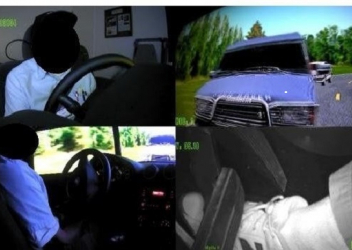Research In Action
Research In Action
Breadcrumb

Pedestrian collision braking detection systems make an impact in the real world, but there is room for improvement in driving situations that are not currently tested as part of safety assessment tests. A motor vehicle with automatic emergency braking (AEB) and pedestrian-detection technology can sense an impending collision and automatically activate the brakes if the driver does not do so in time. The need for this type of technology is urgent, since the number of pedestrians killed in automobile crashes rose by more than 50% between 2009 and 2019, and made up about a fifth of all traffic fatalities in 2019.
Earlier this year, a study by the Insurance Institute for Highway Safety (IIHS) evaluated nearly 1,500 police-reported crashes with vehicles from different manufacturers and compared pedestrian crash rates for identical vehicles with and without AEB and pedestrian detection technology.
AEB Performance in the Dark
One finding of concern is that while AEB with pedestrian detection technology reduced pedestrian injury-causing crashes during daytime or lit conditions by ~30% (32% in the daylight and 33% in areas with artificial lighting during dawn, dusk and nighttime), there were no differences in crash risk among vehicles with and without AEB on nighttime roads without street lighting. As a response, the IIHS is developing a new type of nighttime pedestrian test: in full darkness on a covered track, with low- and high-beam headlights.
AEB Performance at High Speed
Another finding from the study is that there was no difference in crash risk among vehicles with and without pedestrian AEB systems at speeds of 50 mph or greater. On roads with speed limits of 25 mph or less, vehicles with pedestrian AEB systems were associated with a 32% reduction in odds of a pedestrian crash; on roads with 30-35 mph speed limits, cars with pedestrian AEBs were associated with a 34% reduction in the odds of a pedestrian crash. Earlier this month, IIHS announced plans to increase the speed of their front crash tests to 45 mph to further evaluate AEB performance at speeds that reflect more real-world crash situations.
The Importance of Ongoing Evaluation
These findings are consistent with previous CIRP research showing that sub-optimal conditions like weather and high speeds reduced vehicle AEB performance. My colleague Thomas Seacrist, PhD also previously blogged about his recently published research highlighting non-standard driving conditions and weather conditions as target areas for improvement in advance driver assistance system technologies. While pedestrian AEB technology is effective at reducing injury-causing crashes overall, there is room for improvement, particularly in un-lit nighttime conditions which is when nearly 75% of pedestrian fatalities occur. The findings from the IIHS study highlight the importance of ongoing evaluation and updated testing standards.




